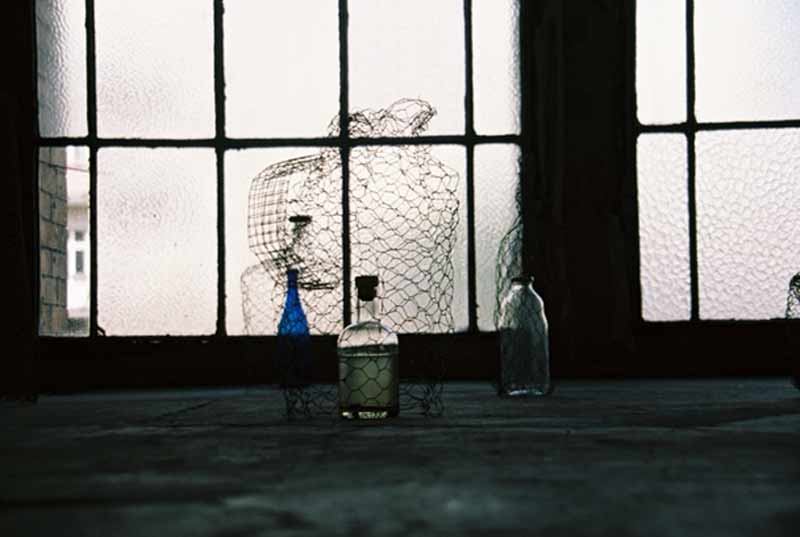.... Continuation of the text ....
Just like the Return to Sender art installation by The Nest Collective (also from Nairobi, Kenya), that Kute saw in Kassel, the award-winning textile and industrial design practitioner aimed to reduce, in a minuscule way, the export of waste from countries from the Global North to countries in the Global South, whilst creating awareness around the multitudinous damage the fast fashion industry inflicts on the environment.
The exhibition continued with a towering water fountain made of barrels, hoses and water - produced by the team led by Brazilian artists Thaís Machado and Isadora Canela. The title O amanhã não está a venda (2022) translates into the popular saying ‘The future is not for sale’ - which was written in various other languages, from Twi to Swahili, and refers to waste and overproduction of resources, which future generations face the consequence of. The sound of the water dripping from the fountain was amplified, so it acoustically and metaphorically emphasized that one day, there might not be any water left.
Theophilus Kwesi Mensah is a sculptor, painter and performer born in Ghana. Menshah led the art installation Clay Heads. The small human skulls which comprise this work are made from eco-friendly and biodegradable clay extracted from water bodies around Karnitz and assembled on silver trays, with empty water vessels hanging ominously above these sculptural pieces. The facial expression of each sculpture is marked by a disturbing and desperate thirst and yearning for water.
In a panel discussion between all the artists on day two of the exhibition, Mensah articulated the significance of pure water in the Ghanaian culture – also referring to his installation Bottles. Referring to his installation made of upcycled plastic kites, Hugo Haddad passionately responded to Mensah’s provocation, acknowledging how easily the world becomes imbalanced when ecosystems are threatened. Together with his Brazilian colleagues, Haddad is committed to researching and working on the exploitation of mines in the state of Minas Gerais and the repercussions on land, society and democracy in Brazil. Consequences that disproportionately affect countries in the Global South, where colonial empires started to drill for resources. A commentary that artist Shonisani Netshia portrayed in her abstract painting inspired by mining waste in South Africa.
The collaborative installation Becoming River was a 19-minute video projected on the same 124m long white fabric piece that was used in a performance two weeks prior to this exhibition, during the artists’ residency in Karnitz. The video shows all participating artists carrying the piece of fabric onto an arid and parched corn field in the evening light, located in an area in Eastern Germany that has been suffering acutely from global warming for years. With the white fabric laid down on the floor, it evoked the image of a river, revitalising a field that was harvested in late August. In their performance, the artists then ‘washed their clothes’ in the metaphorical river, an ode to traditional human labour, fast fashion consumption and the purifying energy of water.

In her artwork Amphora Uterus, Lis Haddad compares the privatization of water to the fertility of a female body.
As a photographer and filmmaker Hugo Haddad was responsible for a 2-channel video installation (Myriad, 2022) that interrogated the mining industry through a specialised AI program. Other outstanding works of the exhibition were paintings by Christian Kabuß, which showed the fragile constitution of man and the work of Juste Constant Onana Amougui responding to water pollution. Please refer to the individual artwork descriptions on this site for a more detailed description.
CONCLUSION
So what can we learn from this exhibition which attracted around 3.000 visitors, but was only up for a single weekend? As a starting point and framework, documenta fifteen focused on the process of art making in the context of people rather than the exhibition of shiny new artworks. Building upon this discourse, the exhibition WATER BODIES also showcased a collaborative spirit spanning across continents, playfully yet consciously exploring and researching our ever-evolving relationship with the world. By delving beneath the superficial layer that enshrouds the art market, the installations were able to tackle human emotions, existential quests and political mistrust in a tangible and genuine way.
The residencies in Kassel and Karnitz were able to create a safe space for the artists to learn from one another and re-write Eurocentric narratives. Coming up against ecological battlefields across the Global South, the artists negotiated ideas of possession, ownership and exploitation - concepts that continue to define individual mindsets and economic structures even long after the dawn of colonialism.
The artists’ immediate concerns, provoked audiences to rethink their global responsibility and re-connect with indigenous communities and the ancestral wisdom innate within these groups - a source of knowledge to understand and preserve our planet. Bringing an awareness to the urgency of drastic ecological changes that can be observed across the globe, the show also consolidated its political relevance.
In November, two months after the exhibition, a photo went viral on Instagram (or at least in the geo-targeted region of Berlin). The post showed a light projection on a skyscraper that is currently being erected in Berlin Friedrichshain: THE WRONG AMAZON IS BURNING - it said in capital letters and in opposition to the new Amazon Headquarter in Berlin. Another artistic intervention that proves the planetary vision that is informing art production and activism in the early 2020’s. A provocative statement that harks back to Isadora Canela and her play with fire:
”In 2022 the mountain in front of my house (in Brazil) set fire, the Amazon is burning, South Africa, Angola, US, Europe. Where there is not enough water, the world is on fire. Geographic and thermal extremes meet in the post-industrial apocalypse of the Capitalocene. This is not theoretical.“
Benjamin Merten, +49 (0)176 83447623,
